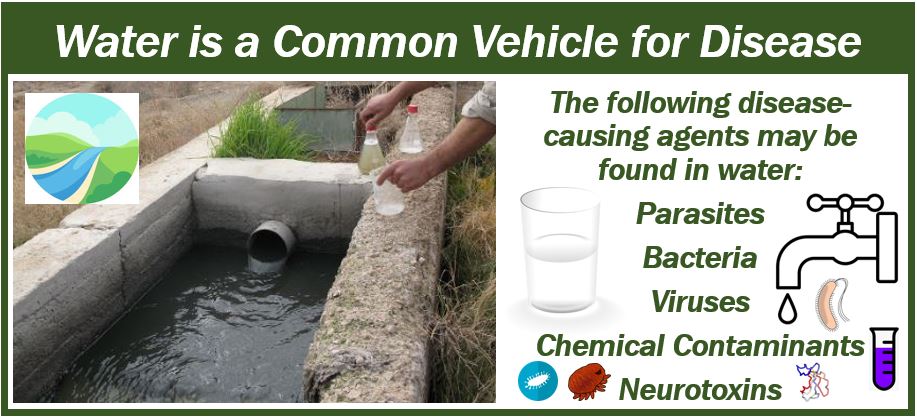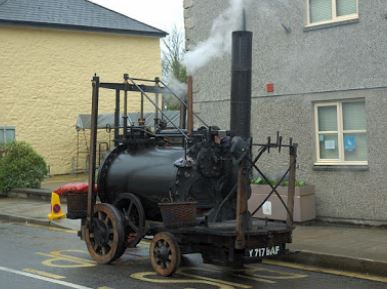Any machine that transports people, animals (live cargo), or cargo is a Vehicle. Cars, trucks, buses, wagons, motorbikes, bicycles, boats, airplanes, and spacecraft, for example, are vehicles. Some dictionaries, however, stress that the term only includes devices that transport people, live cargo, or goods on land.

Most of us tend to use the word only when referring to motor vehicles, i.e., cars, trucks, and other road traffic transportation machines.
Vehicle in medicine
Drugs
In the world of medicine, a vehicle is an inactive substance that we combine with an active ingredient to facilitate administration, i.e., it is an excipient or menstruum. In other words, in a medication, the vehicle is the substance that has no therapeutic action or effect.
Infectious diseases
The term may also refer to an inanimate substance by which a bacterium, virus, or another infectious agent passes from one host (infected host) to another (susceptible host).

The US CDC (Centers for Disease Control and Prevention) says the following regarding the term in an epidemiological setting:
“Vehicles that may indirectly transmit an infectious agent include food, water, biologic products (blood), and fomites (inanimate objects such as handkerchiefs, bedding, or surgical scalpels). A vehicle may passively carry a pathogen — as food or water may carry hepatitis A virus.”
The rest of this article focuses on the term when it refers to a transportation device of people, animals, or goods.
Legal definition (transportation device)
Vehicles are instruments of conveyance (transportation). They may include any type of conveyance we use for transporting cargo, live cargo, or human passengers by land, air, or water. Anything that runs on land using tires is a vehicle.
The meaning of the term can vary slightly depending on the context, sector of the economy, or profession.
History of engine-powered vehicles
Steam-powered
In 1672, Ferdinand Verbiest (1623-1688), a Flemish scientist, a member of the Jesuit mission in China, built a steam-powered 26-inch long scale model toy for the Kangxi Emperor. However, it did not carry humans or cargo. Therefore, technically, it was not a vehicle.
In 1769, Nicolas-Joseph Cugnot (1725-1804), a French inventor, built the first full scale, self-propelled mechanical vehicle. His invention was a steam-powered tricycle. His vehicles had a problem with maintaining steam pressure and having continuous access to a steady water supply.
Richard Trevithick (1771-1833), a British inventor and mining engineer, created the first steam-powered, functioning road vehicle. He called it the Puffing Devil. However, as it could not maintain steam power for long, it had no practical use.

During the first half of the nineteenth century, there were several different types of steam-powered road vehicles, including steam rollers, phaetons, steam buses, and steam cars.
Internal combustion engine and electric car
Nicéphore Niépce (1765-1833) and his brother Claude Niépce (1763-1828), two French inventors, created what they called a Pyréolophore. Created in 1807, it was the world’s first internal combustion engine. In the same year, Swiss inventor François Isaac de Rivaz (1752-1828) created an internal combustion engine. He used it to create the world’s first combustion engine vehicle.
In 1881, French electrical engineer Gustave Trouvé (1839-1902) created the first electric car.
First modern car vehicle
German engine designer and automotive engineer Karl Benz (1844-1929) is acknowledged in the automotive sector today as the inventor of what we know as the modern car. In 1886, he obtained a patent for the motorcar.
Today, we are beginning to see self-driving cars or autonomous vehicles. As artificial intelligence becomes more sophisticated and aeronautical engineering advances, how long will it be before we travel around in our own personal, self-piloting flying machines?
With advancements in technology paving the way for cleaner energy sources, the future of vehicles may see a shift towards environmentally friendly and sustainable modes of transportation.
Etymology
Etymology is the study of where words come from and how their forms and meanings have evolved over time.
According to atymonline.com, the term “vehicle” first appeared in the English language in the 1610s, with the meaning “a medium through which a drug or medicine is administered,” and “any means of conveying or transmitting.”
It came from the French word “véhicule,” which originated from the Latin word “vehiculum,” which meant “means of transport, carriage, conveyance, vehicle.”
